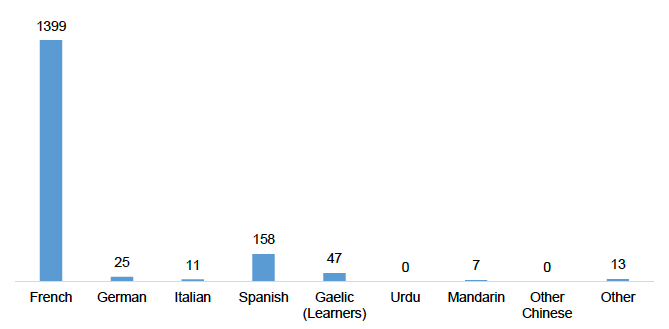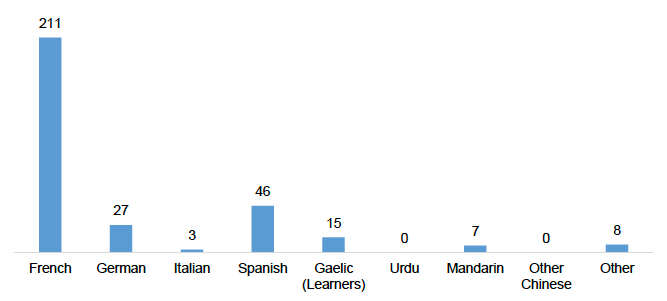1+2 language learning survey: report
Findings from the 2019 survey of local authorities regarding progress with implementation of the 1+2 approach to language learning in Scottish schools.
3. The First Additional Language (L2) in the BGE: Primary, Secondary and Special Schools
3.1. Percentage of schools providing the full L2 entitlement within the terms of the policy
| Mainstream primary schools | 88% |
|---|---|
| Mainstream secondary schools | 70% |
| Special primary schools | 56% |
| Special secondary schools | 56% |
These figures are very encouraging, especially in primary schools where language learning from P1 was not the norm before the introduction of the 1+2 policy. All 32 local authorities reported having mainstream primary and secondary schools providing the full L2 entitlement.
3.2. Languages offered as L2 in the BGE (primary and secondary)
Mainstream primary schools providing the full L2 entitlement [1]

Note: This data contains double counting of some schools, for example a school may offer both French and Spanish as L2. Data has not been through the same validation process as the percentage of primary schools providing the full L2 entitlement.
Of the languages offered in primary schools providing the full L2 entitlement:
- French is the most commonly taught language as L2, being offered in 88% of the schools.
- Spanish as L2 is rising, now reaching almost 10% of the schools.
- Gaelic (Learners) and German as L2 are offered, approximately and respectively, in 3% and 2% of the schools; whilst the other languages are each taught in less than 1% of primary schools.
Other languages offered as L2 in primary schools include: English in Gaelic Medium Education (GME) schools, British Sign Language (BSL)[2], and Makaton[3].
Although some schools will provide more than one language as L2, the majority of primary schools provide the full L2 entitlement in only one language.
Mainstream Secondary Schools providing the full L2 entitlement[4]

Note: This data contains double counting of some schools. Data has not been through the same validation process as the percentage of secondary schools providing the full L2 entitlement.
Of the languages taught as L2 in secondary schools providing the full entitlement:
- French is the most widely taught language, with 89% of secondary schools offering it as L2.
- Spanish is taught in 19% of the schools, German in 11%, and Gaelic (Learners) in 6%.
- The rest of L2 languages are each taught in less than 3% of the schools.
The picture is similar to the one for primary schools providing the full entitlement.
Other languages offered as L2 in secondary include English in GME settings and BSL.
Just under a third of secondary schools which offer the full L2 entitlement provide more than one language as L2.
Special primary and secondary schools providing the full L2 entitlement
The picture is similar to the one in mainstream schools, with French and Spanish being the most widely taught languages, respectively in 59% and 14% of special primary schools, and 54% and 18% of special secondary schools.
Makaton and BSL are also taught as L2 in 28% of special primary schools, and 25% of special secondary schools.
3.3. Models used to deliver the full L2 entitlement in primary schools
The full L2 entitlement is being provided in 88% of primary schools. The models of delivery of L2 are given in the following table:
| Model type | Percentage of schools |
|---|---|
| Class teacher embedding learning | 83% |
| External Visiting Specialist drop-in | 9% |
| Internal Visiting Specialist drop-in | 17% |
| Team teaching embedding learning | 13% |
| Other | 7% |
Note: Some schools will use more than one model type. The percentages will therefore add up to more than 100%.
The majority of primary schools reported having a model in place where the class teacher delivers the L2, blending the target language throughout the school day. For example, in class routines such as taking the register, noting school lunches and, from approximately P3/P4 stage, through teaching discrete lessons in the L2.
Schools also give examples of providing models whereby class teachers from P1 to P3 embed language learning, but then move to a specialist 'drop-in' model from P4 onwards. The 'drop-in' model reported by schools is either provided by a specialist within the school, using non-class contact time, or from an external specialist, e.g. a teacher at the cluster secondary school. Some schools describe addressing the need for all teachers to deliver languages through provision of team-teaching opportunities.
A number of schools reported that they supplement the delivery of the L2 through lunchtime clubs for pupils, parental support (where parents are either native speakers or have a level of fluency in the language), input from undergraduate languages students at local universities, or from regular visits by S5/S6 'languages ambassadors' from the cluster secondary school.
Contact
Email: ceu@gov.scot
There is a problem
Thanks for your feedback